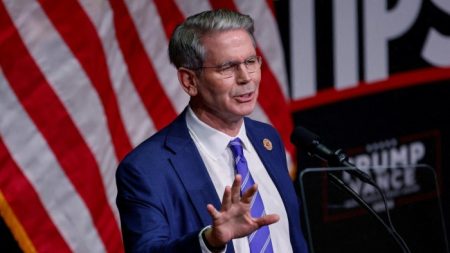Last year, consumers shelled out big bucks for their back-to-school shopping needs, spending a record $41.5 billion, according to estimates from the National Retail Federation.
That whopping tally, which amounted to more than $890 per household, bested 2021’s all-time high by roughly 12%. While higher prices sure played their part, so did buoyed optimism in the strong labor market, plus slowing inflation and the resilient US economy.
This year, consumers have grown more tempered. Although higher-than-typical inflation is just about snuffed out, consumers have pulled back as they feel the compounding effects of price hikes and navigate through an economic slowdown that, while expected, is feeding into uncertainty.
Still, there’s enough of a foundation there that the NRF expects 2024’s back-to-school spending to be the second-highest on record at $38.8 billion, or $874.68 per household.
To what extent that bears out could prove to be a critical barometer, not only for how people are approaching their spending, but also for the health of the consumer-powered economy.
“There still seems to be quite a lot of intent to go out and spend,” Mark Mathews, NRF’s executive director of research, told CNN.
People have just become “very, very price-conscious,” he added.
Bargain hunting and cheaper supplies
Any other time of year, items like stationery, apparel and electronics would fall under the discretionary spending umbrella.
And, broadly speaking, it’s the discretionary and bigger-ticket spending that have seen some of the biggest drop-offs amid the spending slowdown.
But back to school is a unique animal.
“Back to school is not a discretionary event; it’s really essential spending,” Mathews said. “If you’re sending your kid off to college, you’ve got to buy furniture. You’ve got to buy shoes, because kids continue to grow.”
While consumers can’t cut out essential spending, they can cut back; NRF surveys have shown that about 41% of respondents say they’re seeking out deals.
“Consumers are definitely out there looking for sales,” he said. “Retailers recognize with price-conscious consumers that you really have to be promotional.”
The shifting tides of inflation are likely helping in those matters. While the pace of price hikes has remained higher than normal, it’s been services-based categories — specifically housing-related services — providing that upward pressure, Consumer Price Index data shows.
Smoother-running supply chains and consumers gravitating toward spending on services and experiences have helped goods categories see disinflation (prices rising but at a slower pace) or even deflation (prices falling).
Retail prices are expected to fall 0.7% this year, after rising 5.9% in 2022 and 0.6% last year, according to an analysis from S&P Global Market Intelligence economists released last week.
Some commonly purchased school supplies are indeed cheaper than last year, and a couple are even below 2019 prices, according to monthly retail tracking data from Circana, a market research company.
Sticky notes are down 22% from this time last year; paper is down 20%; and crayons and pencils are down 19% and 13%, respectively. Crayons and self-stick notes are even down from 2019, by 7% and 12% (whereas the other categories are at least 11% higher), Circana data shows.
Average hourly and weekly earnings have been running above inflation for well over a year now, Bureau of Labor Statistics data shows, keeping economy-powering consumer spending churning.
As such, back-to-school spending volumes should remain fairly in line with last year, Duleep Rodrigo, KPMG’s US consumer and retail sector leader, told CNN in an interview.
“What was surprising for us was that we saw some more positive sentiments from consumers as it relates to fall shopping,” Rodrigo said of the accounting firm’s most recent consumer survey.
In many instances, that’s a reversal from the summer survey, where outlooks appeared much more dour, he said, attributing the increase to higher expectations around interest rate cuts and discounts.
It also could bode well for the all-important holiday shopping season, he said.
“They’re much more optimistic in spending,” he said.
For some families, spending — especially back-to-school spending — is certainly looking a lot different than it has in years past.
In Shoreline, Washington, Amanda Webber and her family have been buckling down financially for quite some time now.
Most of the family’s savings have gone toward paying down the medical costs associated with Webber’s brain surgery earlier this year. She’s recovering well and expects to go back to work soon, but the monthly budget took a big hit.
The family has been economizing by shopping more at Costco, buying in bulk from the butcher, preparing meals long in advance and keeping that A/C unplugged to help lighten the electricity bill.
Back-to-school spending is no exception to the rule.
“I’m working the deals,” Webber said, noting she’s finding coupons online, doing more comparison shopping, digging into clearance racks and participating more in her neighborhood’s “buy nothing” group.
She and her husband even ripped out sheets from the black-and-white marbled composition books they have on hand in order to reuse them.
As such, the money actually spent has been quite targeted, Webber said, noting the bulk of it went to buying their 16-year-old daughter an interview- and presentation-ready outfit.
“I think the shoes were the most expensive part of it,” said Webber, 49.
In Gainesville, Florida, Lisa Castruita, 46, and her teenaged daughter live by a simple mantra: “Do more with less, or make do with what you have.”
“People just have to be smart about the things that we do and the moves that we make,” Castruita told CNN. “People in older generations, they did so much with so little.”
The pandemic and the personal and economic upheaval that followed were transformational for Castruita, who lost her husband in 2021 to Covid.
“Years ago, I had support there and more income, and I didn’t think twice about ‘new everything,’ new notebooks, nothing but the best,” she said. “When you’re a single parent or a single-income family, you can feel it … all of those (price hikes) add up. I’m a widow, and I just feel like I have had no choice but to take a smarter, more measured approach.”
As her daughter enters the 11th grade, Castruita said she’s intent on not falling into the excess of prior back-to-school seasons.
“One thing I noticed is that we recreate the wheel and put ourselves in debt for no reason,” she said. “I would spend money on things and 50% of that stuff would be unused.”
In addition to being resourceful, seeking out deals and shopping at secondhand stores, Castruita said her friends and family, whom she lovingly refers to as her “tribe,” have been an invaluable resource. They’ve shared gently used clothing, a haircut and a bookbag for free, or at a discount, or for services provided in return.
As such, Castruita estimates that her retail-level back-to-school spending is about 60% to 70% lower this year than it has been in the past. And curtailing unnecessary spending allows her to put money toward enjoying life experiences with her daughter, she said.
“The current economy does not allow you to do things like we used to,” she said. “It’s about lifestyle changes. It’s about making smart, intelligent, grounded decisions that are going to improve where you are in life.”
Read the full article here













